The Great Disaster of Tokyo, 1923
An earthquake, a fire, a lot of misinformation and unexpected consequences.
Nature is perverse. It acts without concern for the consequences for humans or any other species. Over the years, with the progress of science, in an act of self-defence, we have learned to prepare for some potential disasters. We have even established projections that help us to know, with a high degree of uncertainty, when one of these events will occur.
A hundred years ago, prevention systems were limited and prediction was still unthinkable1. September 1923 arrived in Japan without anyone knowing that, in a few hours, horror would come knocking at the door.
Japan and seismic risk
It is well known that Japan is one of the most earthquake-prone countries in the world. The explanation lies in the archipelago's position in relation to the tectonic plates that constitute the earth's crust. Near Tokyo, two major plates (the Pacific plate to the east and the Philippine Sea plate to the south) and two minor plates (the Amurian plate to the west and the Okhotsk plate to the north) meet. The Pacific plate and the Amurian plate sink each year under the Okhotsk plate, while the Philippine plate dives under the Amurian plate. This continuous tension is responsible for Japan's high levels of volcanic and seismic activity, as shown in the map below.
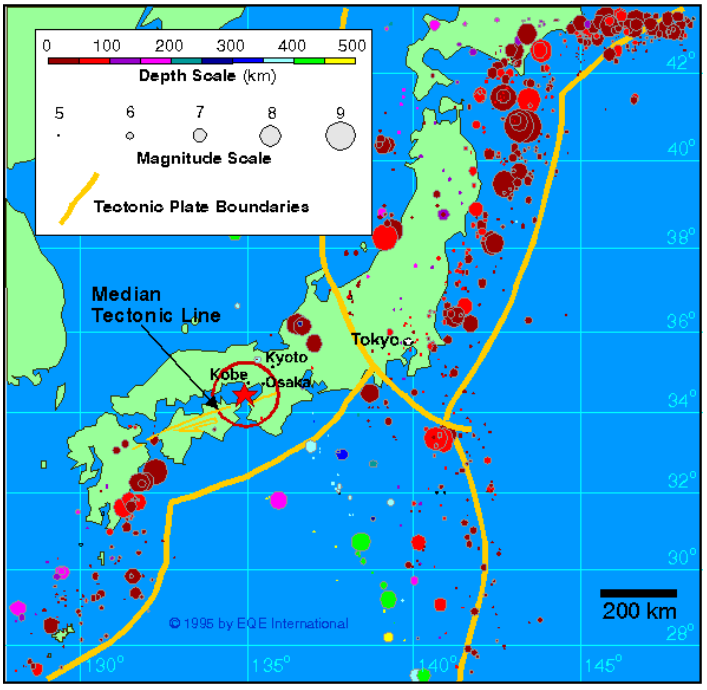
Earthquakes have been linked to the archipelago of Japan for a long time. Many of you will be familiar with the 2011 earthquake that struck off the coast of Fukushima, resulting in a devastating tsunami that claimed the lives of more than 20,000 people. Sadly, this was nothing new for the Japanese. If we go back centuries, there are some documents that mention earthquakes as far back as 416, but the first one that is reliably recorded is the Hakuhō earthquake in 685. Thanks to it, Japanese scholars were able to establish a correlation between the seismic movements and the tsunamis that had been ravaging their coastline for centuries.
Japan's history is a succession of dynasties and emperors, as well as disasters that have caused damage to cities and villages alike. We can list dozens of earthquakes in which towns were swept away and casualties numbered in the hundreds. Sometimes because of the earthquake itself, but many more because of the subsequent tsunami, from which it was impossible to flee.
1 September 1923
Shortly before noon on that Saturday, as was customary, Tokyo residents were preparing food in their kamados2 and chichirin3. Suddenly, the ground began to shake sharply, with an estimated magnitude of 7.94. This caused panic among citizens, as several buildings collapsed. In a city whose main building material was wood, many of the embers and fires from kamados and chichirin ended up trapped in collapsed and highly flammable structures. This caused numerous fires to break out in the minutes following the earthquake. The records of the time only mention 98 fires, although it is quite possible that there were more than several hundred in Tokyo alone.
The coincidence of the earthquake occurring when everyone in Japan was cooking was compounded by two unfortunate coincidences. Despite firefighters and security forces mobilising quickly, they found that the quake had knocked out almost all the water tanks, making it difficult to fight the multiple fires. The rain could have been a good ally, and just the other side of the country was being hit by a typhoon. The water did not come close to Tokyo, but the typhoon did cause gusts of wind that made it easier for the fires to spread across the city. Just a couple of hours after midday, many of the fires converged and, with the help of the powerful winds, created a destructive firestorm that completely swept through the east of the city.
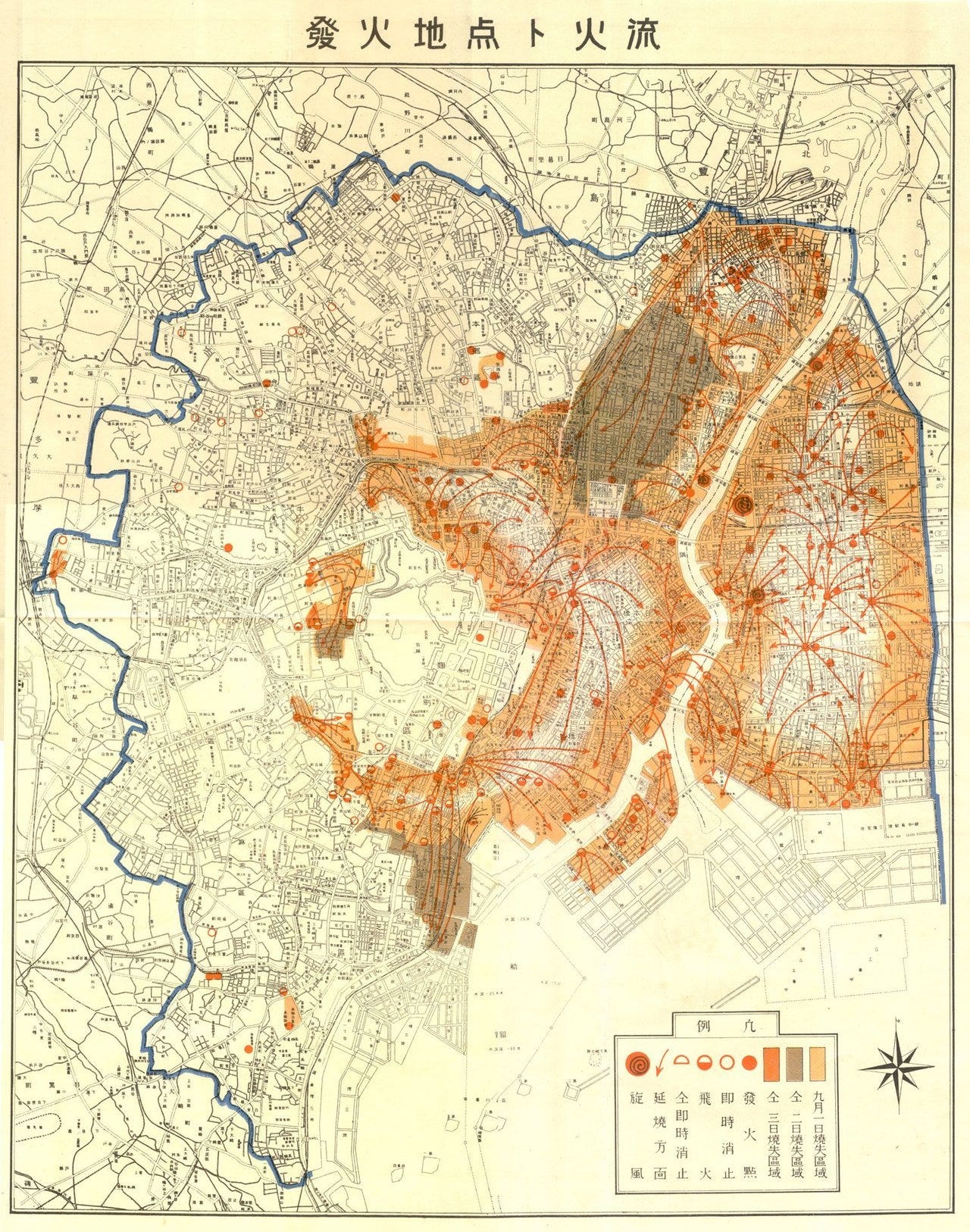
The aftershocks and fires raged for more than two days without Tokyo residents being able to do anything about it5. Many tried to flee, but the crowds and physical barriers, such as the river and the sea, proved impassable frontiers where many met their deaths. Historical data suggest that between 120,000 and 140,000 people lost their lives in those first 48 hours. A few dozen may have died as a direct result of the earthquake, and a few hundred on shores where the tsunami hit, but the vast majority perished in the ensuing fire.
It was not until 3 September that it was possible to return to the city and assess the damage. The authorities found that 48% of Tokyo's surface area was completely burned. Some 400,000 houses were declared dilapidated, which meant that in a city of 2.2 million people, 1.4 million had no roof over their heads. In addition, 121 of Tokyo's 138 central banks at the time were destroyed with all their contents. 162 hospitals and more than half of the schools could not be reused, and nearly 7,000 factories could not reopen. All in all, the citizens of Tokyo who were beginning to prosper, overnight, found themselves homeless, jobless and with nothing to put in their mouths.
Disinformation and racism
We cannot say that humanity has gone down in history for an excess of calm in the face of adversity, and the Great Kanto Earthquake was no exception. Since 1910, Japan had been occupying the Korean peninsula and, despite assimilation efforts, there was a persistent Korean movement to regain independence. The fires and public disorder in the first hours after the earthquake quickly became a rumour that blamed Koreans for taking advantage of the disaster to set fires so that they could rob shops and houses.
This soon turned into a mob that embraced anti-Korean sentiment and began to take justice into their hands with the Koreans in Tokyo and Yokohama. The mob was sophisticated and organised itself into vigilante groups that set up checkpoints at various points. With them, they questioned everyone so that they could identify those who were unable to speak Japanese or who had a Korean accent. This test, of dubious reliability, resulted in a number of Chinese or even Japanese speakers of other dialect variants being mistaken for Koreans and also executed. As is unfortunately common in such cases, several members of the security forces collaborated with these groups, leaving all the oppressed in a situation of total helplessness.
During the first week of September, more than 200 Koreans were killed, according to the figures recorded by the authorities. Other sources estimate that the number could be as high as 6,000 or even 10,000. It would be easy to blame only word of mouth and the chaos of the moment, but newspaper archives have evidence that many newspapers collaborated with the rumours for weeks. Some even blamed the Koreans for poisoning wells from which Japanese citizens were supplied, clearly aimed at maintaining racial tension and hatred of Koreans.
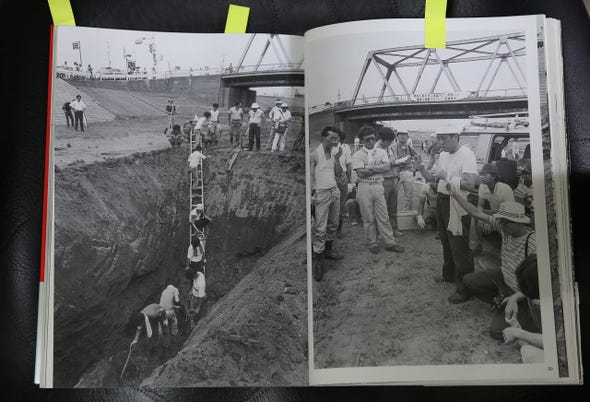
The Japanese military had to act directly to protect Koreans living in Japan. More than 20,000 Koreans were guarded throughout the country, although this did not stop the rumours. There was a police chief who volunteered and drank water from several wells to prove to the citizens that Koreans were not poisoning the wells. The Empire of Japan produced propaganda in the form of pamphlets to distribute to citizens to limit the madness. While these actions did help, many of the vigilante groups established were only dismantled after the use of military force.
This marked a turning point in how information has been handled in Japan during and after a natural disaster. In all training on earthquakes and tsunamis, it is stressed that every citizen must carry a radio device to access reliable information from the government and prevent rumours from spreading in a counterproductive way.
Epilogue
The most important thing after the disaster was reconstruction. Being a destroyed city, Tokyo had the opportunity to become the modern imperial capital, with an improved sewage system, grand avenues, large parks and imposing government buildings. After three months of debating how best to meet the challenge, on 24 December 1923, Japan passed a law giving the city of Tokyo the power to reclaim 10% of its property from all citizens and carry out the ambitious plan. This enabled the capital to become a city of grand avenues and modern urban planning.
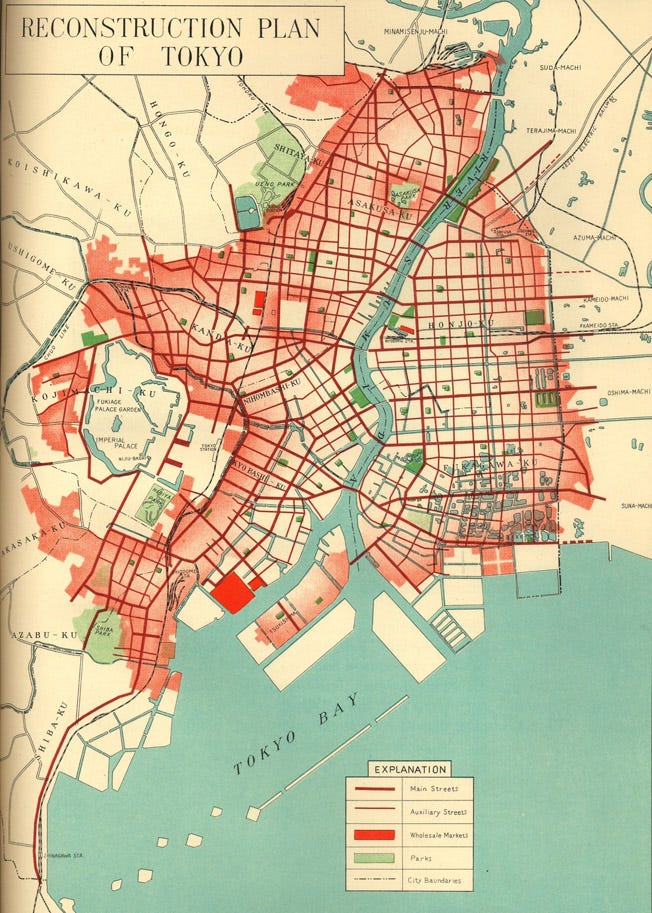
On the geological side, the earthquake also had a considerable impact on the Kanto region. The movement of tectonic plates is responsible for the shifting of continents, the creation of islands and the disappearance of others, but this event is rarely experienced during a human lifetime.
In 1933, ten years after the earthquake, there was a new geological survey of the Kanto region. The data showed significant changes in altitude throughout the region. There were several areas that saw their position raised up to two metres above the surface of the map, while other points sank about two metres from their previous position.
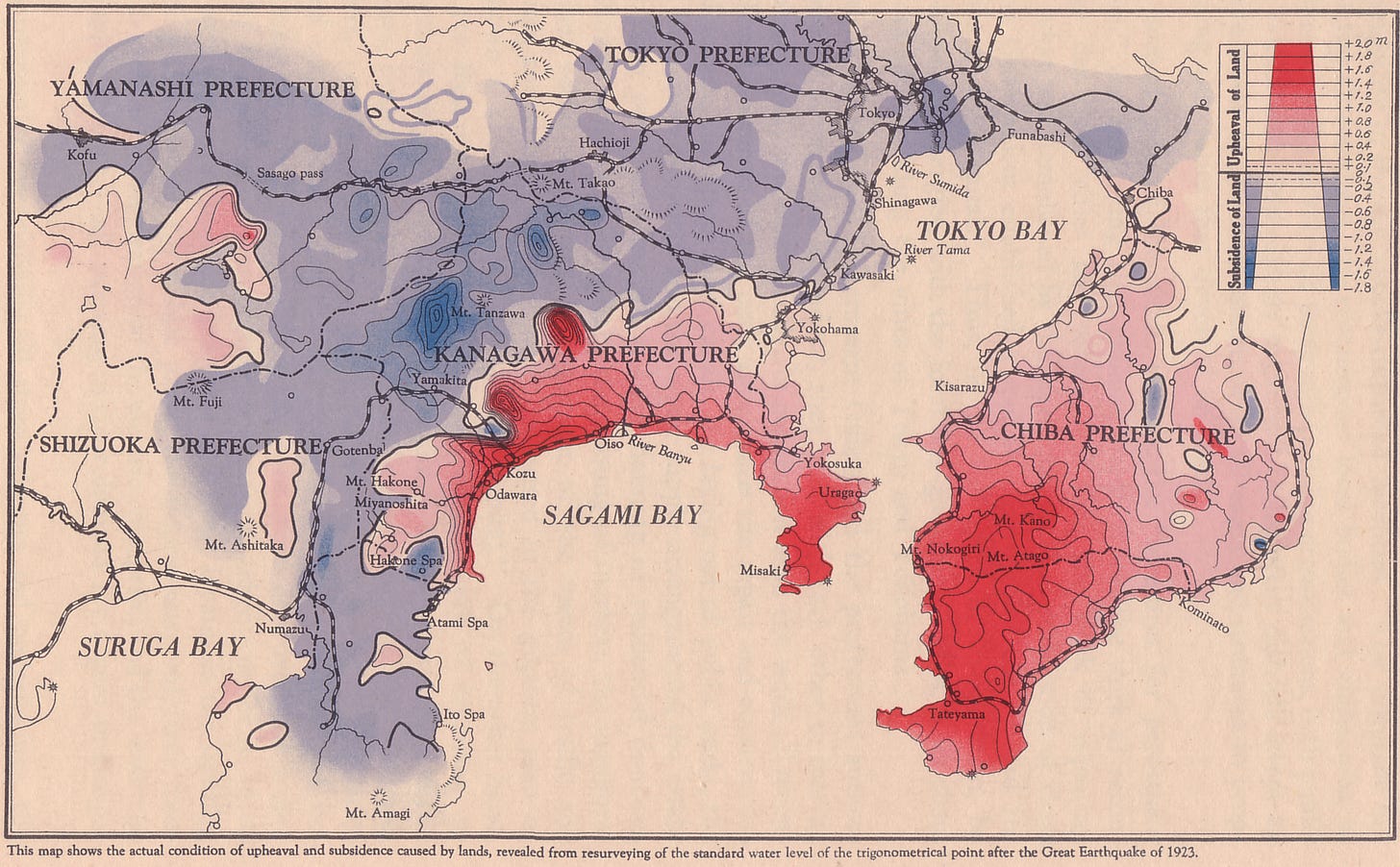
Again, Japan is sadly accustomed to such abrupt changes in its geology. Not only did that earthquake shift the land, but numerous more have continued to do so over the past hundred years. And of course, many more will.
One of the most remarkable cases occurred just a year ago, during the New Year earthquake on the Noto Peninsula. A 7.6 magnitude earthquake caused 500 deaths and multiple damage to infrastructure. As a direct consequence of the earthquake, within seconds the land was permanently raised by four metres and, as a secondary consequence, the coastline retreated by up to 200 metres in some places. The size of Japan grew by 4.4 km² or, in other words, ten times the size of the Vatican6.
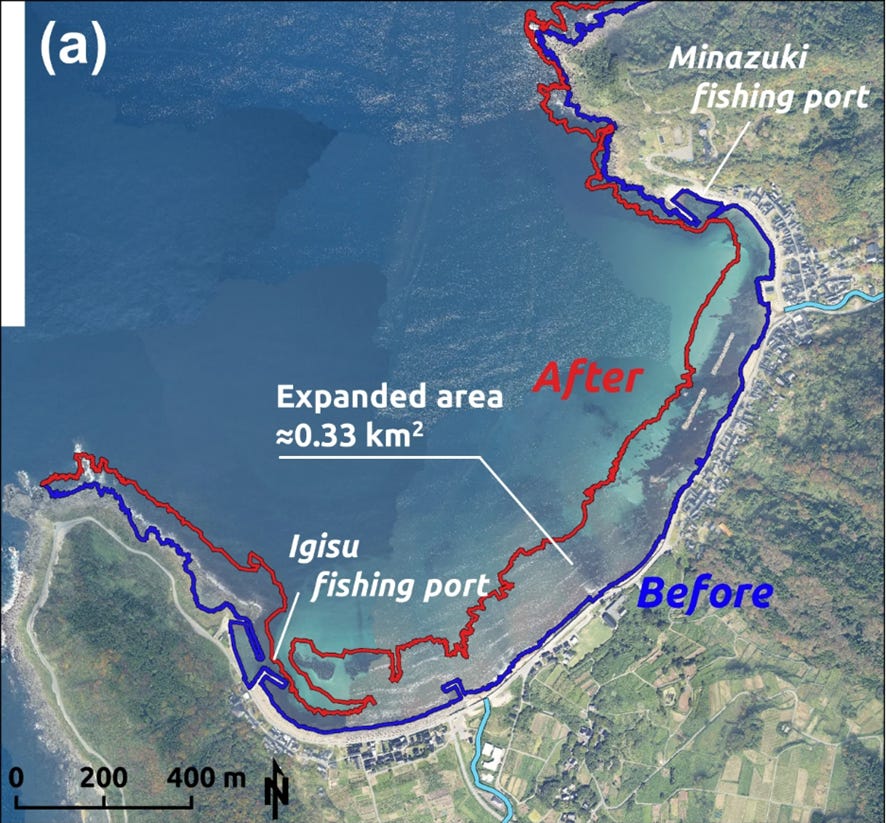
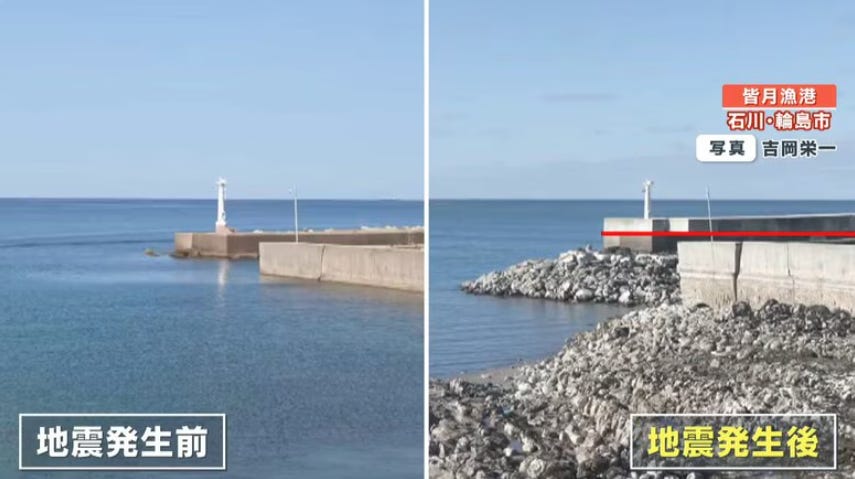
As can be seen on the map, and in the photograph below, several fishing ports became inaccessible in a matter of seconds. Many boats were unable to return and others were unable to leave.
On a positive note, some geologists claimed that, thanks to the unexpected uplift, the tsunami damage was much less than it could have been.
Which is still VERY limited in the case of earthquakes or volcanoes.
Traditional Japanese kitchens.
Charcoal grills.
Since 1973, Japan has recorded nine earthquakes with an intensity of more than 7.
Two years ago, for the commemoration of the 100th anniversary, this impressive interactive website was created where you can see how the fires progressed.
I know the Vatican is a minimal country, but this makes it easier to understand the magnitude.





This text was really interesting. The story, the support with the maps... Or... the maps as an excuse to tell a story. You have been a great discovery and an entertaining read.